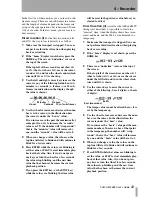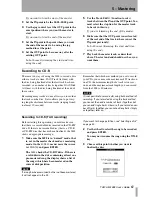
4 – Recorder
TASCAM 2488
User’s Guide
49
The recording between the punch-in and
punch-out points is now replaced by the selec-
tion. The
AUTO PUNCH
indicator goes out.
If you change your mind
Like recording, an punch operation is undoable. It is
shown in the list of operations as an
AUTO PUNCH
oper-
ation.
In addition, as we mentioned earlier, the third choice
when you press the
AUTO PUNCH
key,
LAST TAKE
LOAD
, allows you to select any of the multi-takes from
the last punch session.
However, if you have recorded anything, performed
an undo or redo operation, or any track editing opera-
tions, (whether punch recording or not) since the last
punch session, the list of multi-takes is no longer
available. The list is available of a song has been
saved, closed and reopened, however, if none of the
above operations have been carried out.
NOTE
Even if you undo the recording that has overwritten the
list of multi-takes, the multi-take list will not be avail-
able to you after the undo.
Bouncing tracks
Like many multitrack recorders, the 2488 allows you
to “bounce” a collection of recorded tracks to a
smaller number of tracks. This allows you to record
more than 24 tracks (but once bounced onto a track
or pair of tracks, the original tracks cannot be sepa-
rated out again).
In the case of the 2488, you can bounce up to 23
tracks into one track or 22 tracks into two tracks. In
this case, a stereo track counts as two tracks.
While you are performing a bounce operation, you
cannot use the sub mix facility (“Sub mix” on
page 29).
Making a bounce mix
1
Press the shifted
BOUNCE
key (located above
the
STEREO
fader).
The words
BOUNCE MODE
are displayed on the
home screen while bounce is active.
2
Select the destination. Press the
REC
keys for
a single track (mono bounce), or two tracks
(or a stereo track) for a stereo bounce.
3
Adjust the source tracks’ levels, EQ and pan
positions, etc. for the bounce mix.
TIP
When you monitor the bounce, you are monitoring the
bounce destination. If any EQ etc. is applied to the des-
tination track(s), this is added to the signal you are
monitoring. You may therefore want to make sure that
the EQ is turned off on the destination tracks.
4
Make the recording from the start of where
you want to do the bounce in the normal way.
You can undo the recording if you find that
your bounce mix is not perfect.
5
When you’ve finished bouncing tracks, restore
normal recording mode by pressing
SHIFT
and
BOUNCE
again.
About track editing
One of the most useful features of a disk-based
recorder such as the 2488 is the ability to edit mate-
rial easily. When working with a stereo tape recorder
in the past, the usual editing method involved a white
pencil, a razor blade and sticky splicing tape. This
was not an easy process, and was very difficult to
undo if there were any mistakes.
The 2488 allows you to edit songs, copying and mov-
ing material from one part of a song to another. This
editing is known as non-destructive editing, meaning
that the operation does not actually destroy data, and
you can undo mistaken editing operations easily.
If you have ever used a word-processor on a com-
puter, you will probably find most of the 2488’s edit-
ing operations pretty simple. If you have never used a






























